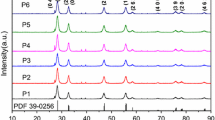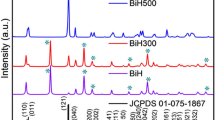Abstract
Bi2MoO6 oxide was synthesized by hydrothermal reaction in the presence of EDTA under different experimental conditions (time of reaction and EDTA concentration) in order to obtain materials with specific textural properties. It was determined that the addition of EDTA influences the final physical properties of Bi2MoO6. The photocatalytic activity of Bi2MoO6 samples was evaluated in the degradation reaction of indigo carmine (IC) in aqueous solution under solar radiation type. The best results as photocatalyst were obtained with the sample hydrothermally synthesized at 150 ºC for 4h in presence of a 0.031 M EDTA solution. This sample was able to whiten a solution of IC in a 94% after 120 min of lamp irradiation with t 1/2 = 31 min. In general, the samples prepared with lower concentrations of EDTA were the best photocatalysts. A gradual decrease in the activity was observed in the samples prepared with the same EDTA concentration as was increased in the reaction time. Beyond differences in morphology and textural properties of the samples prepared, the presence of EDTA by-products on the samples and the decomposition degree of it were important factors in determining the activity of the photocatalysts. Analysis of total organic carbon (TOC) of samples irradiated for 100 h confirmed that Bi2MoO6 oxide is able to mineralize the complex organic molecule of IC to CO2 and H2O in 55 %.








Similar content being viewed by others
References
Bhakoo A, Bond GC, Rees RD, Sauerhammer B, Taylor AO, York I (1999) Supported binary oxide monolayers as selective oxidation catalysts: Bi2Mo3O12/TiO2. Catal Lett 57:55–60
Bi J, Wu L, Li J, Li Z, Wang X, Fu X (2007) Simple solvothermal routes to synthesize nanocrystalline Bi2MoO6 photocatalysts with different morphologies. Acta Mater 55:4699–4705
He D, Ueda W, Moro-Oka Y (1992) Promotion effect of molybdate support on Bi2Mo3O12 catalyst in the selective oxidation of propylene. Catal Lett 12:35–44
Kim N, Vannier RN, Grey CP (2005) Detecting different oxygen-ion jump pathways in Bi2WO6 with 1- and 2-dimensional 17O MAS NMR spectroscopy. Chem Mater 17:1952–1958
Kubacka A, Fernández-García M, Colón G (2012) Advanced nanoarchitectures for solar photocatalytic applications. Chem Rev 112:1555–1614
Li HH, Li KW, Wang H (2009) Hydrothermal synthesis and photocatalytic properties of bismuth molybdate materials. Mater Chem Phys 116:134–142
López Cuéllar E, Martínez-de la Cruz A, Lozano Rodríguez KH, Ortiz Méndez U (2011) Preparation of γ-Bi2MoO6 thin films by thermal evaporation deposition and characterization for photocatalytic applications. Catal Today 166:140–145
Martell AE, Motekaitis RJ, Fried AR, Wilson JS, MacMillan DT (1975) Thermal decomposition of EDTA, NTA, and nitrilotrimethylenephosphonic acid in aqueous solution. Can J Chem 53:3471–3476
Martínez-de la Cruz A, Obregón Alfaro S (2010) Synthesis and characterization of γ-Bi2MoO6 prepared by co-precipitation: photoassisted degradation of organic dyes under vis-irradiation. J Mol Catal A Chem 320:85–91
Martínez-de la Cruz A, Obregón Alfaro S, López Cuéllar E, Ortiz Méndez U (2007) Photocatalytic properties of Bi2MoO6 nanoparticles prepared by an amorphous complex precursor. Catal Today 129:194–199
Murugan R (2004) Investigation on ionic conductivity and Raman spectra of γ-Bi2MoO6. Phys B 352:227–232
Xie L, Ma J, Xu G (2008) Preparation of a novel Bi2MoO6 flake-like nanophotocatalyst by molten salt method and evaluation for photocatalytic decomposition of rhodamine B. Mater Chem Phys 110:197–200
Zhao X, Xu T, Yao W, Zhu Y (2009) Photodegradation of dye pollutants catalyzed by γ-Bi2MoO6 nanoplate under visible light irradiation. Appl Surf Sci 255:8036–8040
Acknowledgments
We wish to thank the Universidad Autónoma de Nuevo León (UANL) for its invaluable support through the project PAICYT 2010 and to CONACYT for supports of the projects CB-167018 and CIAM-148138.
Author information
Authors and Affiliations
Corresponding author
Additional information
Responsible editor: Philippe Garrigues
Rights and permissions
About this article
Cite this article
Sánchez Trinidad, C., Martínez-de la Cruz, A. & López Cuéllar, E. Photocatalytic degradation of indigo carmine by hydrothermally synthesized Bi2MoO6 in presence of EDTA. Environ Sci Pollut Res 22, 792–799 (2015). https://doi.org/10.1007/s11356-014-3004-7
Received:
Accepted:
Published:
Issue Date:
DOI: https://doi.org/10.1007/s11356-014-3004-7




